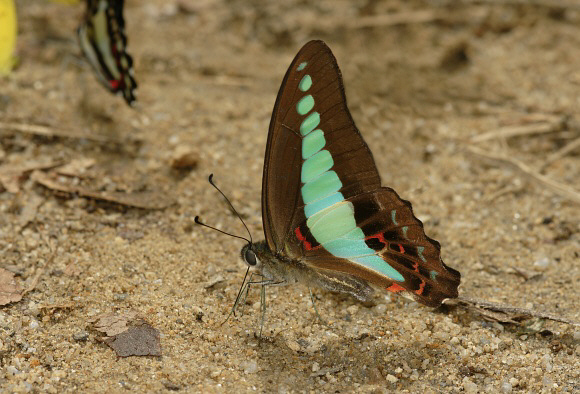Introduction
The genus Graphium is widespread in the Old World, with 35 species in the Afrotropical region, 14 in the Oriental region, 6 in the Holarctic (south & west China), and 20 in the Australian region.
Almost all of the Oriental and Australasian species are characterized by the presence of a pattern of translucent green, turquoise, or yellowish ‘windows’ in their wings. Arguably the most beautiful and unusual of all the Graphium species is weiskei from Papua, which is patterned with vivid pink and green on a dark brown ground color. There are several species, however, such as antiphates and aristeus which have pure white uppersides, marked with prominent vertical black stripes. A few, including antiphates, aristeus, and the African policenes, have very long sword-like tails. Some of the Oriental species, e.g., codrus, cloanthus, and certain races of agamemnon, have short tails, but in others including sarpedon, doson, and eurypylus the tails are greatly reduced or absent.
Graphium sarpedon is the most widespread and common of the Oriental species, found from India and Sri Lanka to China and Japan; and from Malaya to Borneo, Sumatra, Java, Sulawesi, Bali, New Guinea, eastern Australia, and the Solomon Islands.

Habitats
This species occurs in almost all forested habitats at altitudes between 0-1400m but is much more abundant at lower altitudes.
Lifecycle
The eggs are spherical, yellowish, and laid singly on the younger more tender leaves of the larval foodplants, often on saplings or sucker growth around the base of the trees.
The foodplants used vary according to country and location and include Beilschmiedia, Endiandra, Cryptocarya, Cinnamomum, Litsea, Neolitsea (Lauraceae), Annona, Melodorum (Annonaceae), Planchonella (Sapotaceae), and Doryphora (Atherospermataceae).
The fully grown larva is dull green in color, dappled with yellow and darker green, and has a thin cream lateral stripe. On each of the thoracic segments, there is a pair of short black spikes, those on the 3rd segment being connected by a prominent yellow band. There is also a pair of very short white spikes on the anal segment.
The wedge-shaped chrysalis is pale green with pale lateral and dorsal stripes which converge at the tip of the thoracic horn. It is attached vertically by the cremaster and a silken girdle to a stem or to the underside of a leaf.
Adult behaviour
Graphium species are generally more robust than their relatives in Papilio and have a stronger and more purposeful flight. Graphium sarpedon, in particular, is noted for its agility and speed in flight.
Prior to mating, both sexes can often be seen circling around the tops of flowering trees, using these as assembly points where courtship takes place.
After mating, males visit damp sand and gravel to obtain essential minerals to replace those lost during sperm transfer. In Malaysia and India males often aggregate with other Graphium species such as doson and antiphates, in groups of up to 50. These aggregations are much less common in Sri Lanka, where mud-puddling males are usually seen singly or in groups of no more than 5 or 6.
As with other Graphium species, sarpedon males adopt the ‘filter-feeding’ technique – using their proboscises to continually suck up water from which they extract sodium and other minerals. They constantly pump the water through their bodies, expelling the surplus from the anus, and using it to dissolve further minerals from the ground, which they re-imbibe.
When feeding on the ground, the wings are normally held erect but kept constantly quivering. It is common to find that almost all the butterflies in an aggregation face in the same direction – into the wind. The wing shape, translucent ‘windows’ and posture of the aggregating butterflies conjure up an image of a flotilla of tiny green sailboards.
